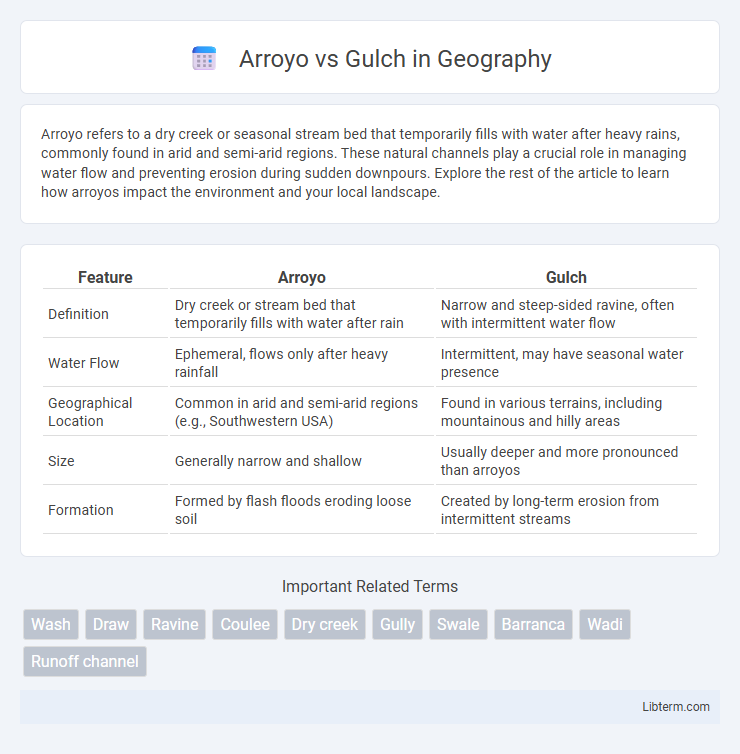Arroyo refers to a dry creek or seasonal stream bed that temporarily fills with water after heavy rains, commonly found in arid and semi-arid regions. These natural channels play a crucial role in managing water flow and preventing erosion during sudden downpours. Explore the rest of the article to learn how arroyos impact the environment and your local landscape.
Table of Comparison
| Feature | Arroyo | Gulch |
|---|---|---|
| Definition | Dry creek or stream bed that temporarily fills with water after rain | Narrow and steep-sided ravine, often with intermittent water flow |
| Water Flow | Ephemeral, flows only after heavy rainfall | Intermittent, may have seasonal water presence |
| Geographical Location | Common in arid and semi-arid regions (e.g., Southwestern USA) | Found in various terrains, including mountainous and hilly areas |
| Size | Generally narrow and shallow | Usually deeper and more pronounced than arroyos |
| Formation | Formed by flash floods eroding loose soil | Created by long-term erosion from intermittent streams |
Introduction to Arroyo and Gulch
An arroyo is a dry creek or stream bed that temporarily fills with water after heavy rainfall, commonly found in arid and semi-arid regions. A gulch is a narrow, steep-sided ravine formed by the erosion of running water, typically more permanent and deeper than an arroyo. Both landforms play crucial roles in the drainage and erosion processes within desert and mountainous landscapes.
Defining Arroyo: Key Characteristics
An arroyo is a dry creek or stream bed that fills with water only during heavy rains or flash floods, typically found in arid or semi-arid regions like the southwestern United States. Key characteristics include its steep-sided channel, intermittent flow, and loose sediment that can rapidly erode during rain events. Unlike a gulch, an arroyo often has a wider, more defined channel with noticeable signs of water flow and sediment transport.
What is a Gulch? Understanding the Term
A gulch is a narrow and steep-sided ravine or valley, often formed by the action of water erosion over time. It typically features a marked drop in elevation, with a stream or intermittent water flow running through its base, distinguishing it from broader valleys or dry channels. Understanding the term "gulch" helps clarify its geological formation and differentiates it from an arroyo, which is generally a dry creek bed that only carries water during rainfall.
Major Differences Between Arroyo and Gulch
An arroyo is a dry creek or stream bed that temporarily fills with water after heavy rains, primarily found in arid and semi-arid regions, characterized by steep banks and sporadic flow. In contrast, a gulch is a narrow, steep-sided ravine, often permanently dry, formed by the erosion of running water over time and typically larger and deeper than an arroyo. The major differences lie in their hydrology, with arroyos exhibiting episodic water flow, while gulches serve more as geographic landforms shaped by sustained erosion.
Geological Formation Processes
Arroyos form through rapid erosion caused by intense, episodic rainfall that carves narrow, steep-walled channels in arid and semi-arid landscapes. Gulches develop from slower, more continuous runoff processes that gradually deepen and widen the valley floor, often with vegetation stabilizing the sides. Both features result from fluvial erosion but differ in sediment transport rates and hydrological intensity influencing their morphological characteristics.
Common Locations and Habitats
Arroyos and gulches commonly form in arid and semi-arid regions where intermittent water flow shapes the landscape. Arroyos typically appear in desert environments such as the southwestern United States, serving as dry creek beds that channel seasonal rainwater. Gulches are often found in mountainous or hilly terrains, cutting narrow valleys or ravines through soil and rock, supporting more diverse vegetation due to varying moisture levels.
Ecological Importance of Arroyos and Gulches
Arroyos and gulches serve critical ecological functions by channeling stormwater and preventing soil erosion in arid and semi-arid regions. These landforms create unique microhabitats that support diverse plant and animal species adapted to periodic water flow and dry conditions. Their role in groundwater recharge and nutrient cycling underscores their importance in maintaining regional biodiversity and ecosystem resilience.
Human Interaction and Utilization
Arroyos and gulches serve distinct roles in human interaction and utilization, with arroyos often functioning as dry creek beds that channel seasonal water flow, enabling efficient land drainage and temporary water supply for agriculture and livestock. Gulches, characterized by their steep sides and deeper cuts, are frequently utilized for mining operations and recreation due to their rugged terrain and concentrated water runoff. Both landforms influence settlement patterns by impacting accessibility, land use planning, and natural resource management in arid and semi-arid regions.
Case Studies: Famous Arroyos and Gulches
The Arroyo Seco in California exemplifies a famous arroyo, noted for its seasonal water flow and urban watershed management challenges. In contrast, the Ruby Gulch in Alaska serves as a prominent example of a gulch, characterized by its narrow, steep-sided ravine formed through intense erosion processes. These case studies highlight the geological and hydrological distinctions critical for environmental planning and land use policies.
Conclusion: Choosing the Right Term
Arroyo and gulch both refer to dry creek beds or channels that temporarily fill with water during rainfall, but an arroyo typically describes a larger, more defined channel found in arid regions, while a gulch is generally smaller and can be found in various terrains. Selecting the right term depends on the specific geographic context and the scale of the landform, with arroyo often used in southwestern U.S. deserts and gulch common in mountainous or hilly areas. Understanding these distinctions ensures precise communication in geology, hydrology, and environmental studies.
Arroyo Infographic

 libterm.com
libterm.com